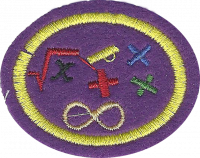Difference between revisions of "AY Honors/Math Skills I/Answer Key/en"
From Pathfinder Wiki
< AY Honors | Math Skills IAY Honors/Math Skills I/Answer Key/en
(Updating to match new version of source page) |
(Updating to match new version of source page) |
||
| Line 63: | Line 63: | ||
<noinclude></noinclude> | <noinclude></noinclude> | ||
==References== | ==References== | ||
| − | |||
<noinclude></noinclude> | <noinclude></noinclude> | ||
{{CloseHonorPage}} | {{CloseHonorPage}} | ||
Latest revision as of 16:22, 14 July 2022
1
Know the decimal system.
2
Know how to identify and classify the algorithms of the decimal system and represent the position of each.
3
Classify and identify the four basic operations, representing each algorithm by using four examples.
4
Show four practical examples in which the four basic operations are used and solve.
5
Investigate and present with a design or in writing the possible origin of the signs of square root, division, addition and subtraction.
6
Demonstrate in practice the solution of at least three examples of exponentiation and three examples of numerical expression, using the signs of parentheses, brackets and braces.
7
Present and solve three practical examples of situations involving fractions in addition, subtraction, multiplication and division operations. Remember that LCM is used for addition and subtraction operations.
8
Present and demonstrate the solution of three problems that involve percentage calculations for purchase and sale of products, obtaining discounts.
9
Present and demonstrate the solution of four operation examples with decimal numbers in addition, subtraction, multiplication and division, using the practical method to solve.
10
Present with a poster or multimedia five examples of flat figures and five examples of solid figures showing their characteristics, and next to it what type of day-to-day object uses that shape.



